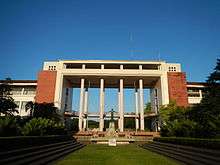Juan Nakpil
Juan Felipe de Jesus Nakpil (born Juan Felipe Nakpil y de Jesus; May 26, 1899 – May 7, 1986), known as Juan F. Nakpil, was a Filipino architect, teacher and a community leader. In 1973, he was named one of the National Artists for architecture.[2] He was regarded as the Dean of Filipino Architects.
Juan F. Nakpil | |
|---|---|
| Born | Juan Felipe Nakpil y de Jesus May 26, 1899[1] |
| Died | May 7, 1986 (aged 86) |
| Nationality | Filipino |
| Alma mater | University of the Philippines University of Kansas Fontainebleau School of Fine Arts |
| Occupation | Architect |
| Spouse(s) | Anita Agoncillo Noble |
| Parent(s) | Julio Nakpil Gregoria de Jesús |
| Awards |  National Artist of the Philippines |
Biography
He was the eighth children of the Philippine Revolution veterans Julio Nakpil and Gregoria de Jesús (who married the former after the death of her first husband Andrés Bonifacio).[3] He died in Manila in 1986.
Education
He studied Engineering at the University of California and later, at the University of Kansas, where he received his bachelor's degree in Mechanical Engineering. He then studied Architecture at the Fontainebleau School of Fine Arts in France upon the recommendation of Jean Jacques Haffner, one of his professors at the Harvard Graduate School of Architecture.[4]
Career
Nakpil worked at Andres Luna de San Pedro's architectural firm (1928) and at Don Gonzalo Puyat & Sons, opening his own architectural firm in 1930.[5] Among Nakpil's works are San Carlos Seminary, Geronimo de los Reyes Building, Iglesia ni Cristo Riverside Locale (Now F. Manalo, San Juan), Magsaysay Building, Rizal Theater, Capitol Theater, Captain Pepe Building, Manila Jockey Club, Rufino Building, Philippine Village Hotel, University of the Philippines Administration[6] and University Library, and the Rizal Shrine in Calamba, Laguna. He also designed the International Eucharistic Congress altar and improved the Quiapo Church in 1930 by erecting a dome and a second belfry. The church burned down in 1929 prior to Nakpil's redesign of the building.[7] In the 1930s to the 1940s, Nakpil and his fellow architects Andres Luna de San Pedro, Fernando Ocampo and Pablo Antonio started the period of modern architecture in the Philippines.[8] Nakpil and others also established the Philippine College of Design in 1941 but the institution did not survive the Second World War.[9] He was hailed as a National Artist for Architecture in 1973.[10]
Projects
Theaters
- Gaiety Theater, Manila (now inactive)
- Rizal Theater (since demolished; the site is occupied by Shangri-La Hotel Makati City)
- Capitol Theater (now inactive)
- University of the Philippines Theater and carillon tower
Other buildings

- Arellano University Building
- Philippine Trust Co. Building (Plaza Goiti [now Plaza Lacson])
- Geronimo Delos Reyes Building
- Capitan Pepe Building
- Manila Jockey Club
- San Carlos Seminary
- Philippine Village Hotel (closed in 2000)
- University of the Philippines Administration & Library
- Rizal Shrine
- Gala-Rodriguez Ancestral House
- University of the Philippines Los Baños Old Humanities Building
- Philippine National Bank building - Visayas
References
- Mendoza, Guillermo. (1973). "Pioneer in Philippine Architecture." The National Artists of the Philippines. Pasig City: Cultural Center of the Philippines (CCP) and Anvil Publishing. 1998.
- Art: Perception & Appreciation. Goodwill Trading Co., Inc. p. 301. ISBN 9789711109332. Retrieved 30 January 2019.
- Antoja, M. (1998). My Country and My People 4. Rex Bookstore, Inc. p. 232. ISBN 9789712322532. Retrieved 29 August 2018.
- Mendoza, G. (1973)
- Mendoza, G. (1973)
- Klassen, Winand W. (1986). Architecture in the Philippines: Filipino Building in a Cross-cultural Context. University of San Carlos. p. 188. ISBN 9789711000493. Retrieved 29 August 2018.
- Zialcita, Fernando Nakpil (2006). Quiapo: Heart of Manila. Cultural Heritage Studies Program, Department of Sociology and Anthropology, Ateneo de Manila University. p. 156. ISBN 9789719367307. Retrieved 30 January 2019.
- Salvan, George Salinda (2000). Architectural & Const. Data. Goodwill Trading Co., Inc. p. 230. ISBN 9789711110420. Retrieved 30 January 2019.
- Contemporary Philippine Culture: Selected Papers in Arts and Education. Japan Foundation, Manila Office. 1998. p. 65. Retrieved 30 January 2019.
- "The National Artists of the Philippines: Juan F. Napkil". National Commission for Culture and the Arts. Archived from the original on 26 July 2014. Retrieved 19 March 2012.